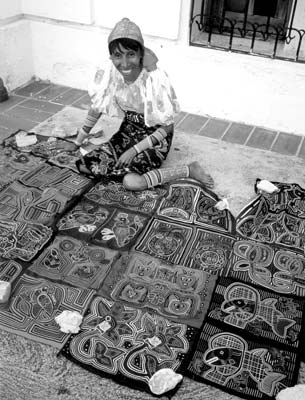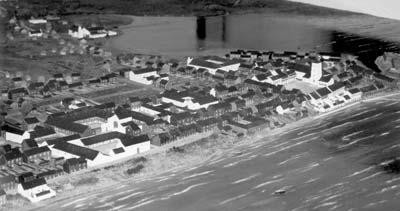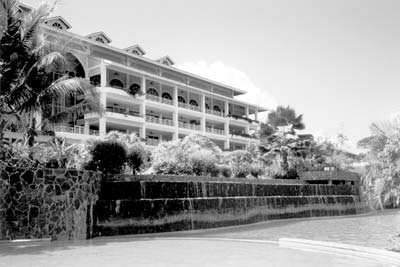Beyond the Panama Canal
by Julie Skurdenis
Mention Panama and most people think Panama Canal. There is no doubt that the 50-mile-long canal, completed in 1914, that cuts across Panama from the Atlantic to the Pacific is one of the most spectacular feats of modern engineering. It would be a mistake for any visitor to Panama to miss at least a partial transit of the Canal or, failing that, a visit to Miraflores Locks to see the locks up close and in operation.
But Panama offers so much more besides: for a start, tropical rainforests for wildlife and birds, beaches and islands for relaxing, and mountain villages for hiking. Then there’s Panama City with excellent hotels, good dining, a few good museums and two wonderful historical areas — La Vieja and Casco Viejo — both rich in remnants from Panama’s colonial past.
The first Panama City
The older of these two sections is La Vieja (The Old One), located at the eastern edge of Panama City. Founded in 1519 by the Spanish conquistador Pedro Arias de Avila, Panama la Vieja — the original Panama City — grew quickly to become one of Spain’s most important cities in the Americas.
Situated on the Pacific, it served as a conduit for the gold and silver flowing from the mines of Peru and Bolivia which was shipped here to be carried across the isthmus of Panama to Caribbean ports and thence by ship to Spain.
Panama la Vieja had a royal treasury, a cathedral, eight convents and monasteries, churches, hundreds of warehouses and scores of elegant mansions as well as thousands of humbler dwellings. In 150 years the city grew and prospered, its population reaching an estimated 30,000. Everything came to an abrupt end in 1671 when the pirate Henry Morgan and a thousand of his cohorts attacked the city, routed the Spanish soldiers defending it and then proceeded to pillage and loot. A fire completed the devastation.
La Vieja was abandoned and left unprotected and in ruins for more than 300 years. It was only in 1976 that what was left of this colonial capital became a protected historic site and declared a UNESCO World Heritage Site in 2003.
On a small peninsula separated from the rest of the city by a moat were some of La Vieja’s most important buildings: the Casas Reales (Royal Houses), including the royal treasury, customs house and governor’s mansion. They have all but vanished, except for a few stone walls and foundations. Close by, on the other side of the moat, was the Plaza Mayor (Main Square), still visible today, as well as substantial portions of buildings that once stood nearby: the impressive Cabildo de la Ciudad (City Hall), which is adjacent to the equally impressive Cathedral which has a bell tower that may have served both Cabildo and Cathedral; the Bishop’s residence; several large mansions, and the enormous, late-16th-century complex of the Dominican Order.
West of the Plaza Mayor stand the ruins of many of La Vieja’s convents and monasteries, ranged shoulder to shoulder facing the sea and belonging to the Jesuits, the Franciscans, the Mercedarian Friars and the nuns of Our Lady of the Conception. There’s a walkway leading past these remains of La Vieja’s 16th- and 17th-century religious past.
There is a superb small museum at the west end of the archaeological site, a 15-minute stroll from the Plaza Mayor. Admission is $3 for a visit to the enclosed portions of La Vieja, including the museum.
Casco Viejo
After Henry Morgan’s destruction of the original Panama City, it was decided to rebuild five miles southwest on a peninsula that was more defensible. The new settlement, Casco Viejo (Old Casco), was enclosed within sturdy stone walls defended by cannons.
Today visitors to this second Panama City can walk along the top of the stone wall watching ships line up in the distance waiting to enter the Panama Canal. At the base of the wall, in the Plaza de Francia, are plaques with the story of the Canal and of the thousands who died of malaria or yellow fever during its construction. Nearby are vaulted stone dungeons once used by the Spaniards and now housing art galleries and an excellent restaurant, Las Bovedas (called appropriately “The Vaults”). For our dinner there, the two of us paid $75 including drinks and tip.
Casco Viejo is a place to stroll through slowly. It’s a relatively small area and you can see much in just an hour or two. Many of the old colonial buildings are crumbling, although restoration seems to be gathering speed.
As you stroll, you will pass numerous churches, some in ruins like the Church of Santo Domingo and the Church of the Jesuits, as well as those still very much in use like the cavernous Cathedral and the Church of San José with a golden altar that somehow escaped Henry Morgan’s looting of the earlier Panama City (legend says the altar was painted black to protect it).
There are historic parks interspersed among streets lined with colonial buildings: the Parque Bolívar, near where Simón Bolívar met in 1826 attempting to forge a union of Latin American countries, and Plaza de la Independencia, where Panama declared its independence from Colombia in 1903. Overlooking Panama Bay is the beautiful white presidential palace, Palacio de la Garza (Palace of the Herons).
Two “don’t miss” museums are the Museo de Arte Religioso Colonial, housed in a chapel of the ruined Church of Santo Domingo, and the Museo Antropologico, with splendid, well-displayed pre-Columbian statues (actually located just outside the Casco Viejo section, a half mile north).
Be cautious strolling through Casco Viejo, even during the day (leave valuables in your hotel safe), and avoid strolling at night altogether. Don’t miss the chance of dining at Las Bovedas restaurant, but arrive and leave by taxi.
If you go. . .
Our 11-day trip to Panama — including Panama City, Gamboa Rainforest Lodge and the San Blas Islands — was arranged by Latin American Escapes (3209 Esplanade, Ste. 130, Chico, CA 95973; phone 800/510-5999, fax 530/879-9290, e-mail travel@latinamericanescapes.com or visit www.latinamericanescapes.com), which took care of our flights, hotels and tours.
The two of us paid a total of approximately $3,200 for our customized trip, excluding airfare. We combined Panama with Nicaragua (see my January ’06 column), flying from New York to Panama City, Panama City to Managua, and Managua to New York. The cost of the flights via American Airlines from New York to Panama and from Managua to New York was $654 each.
It cost an additional $289 each for the 1_-hour one-way flight on Copa Airlines between Panama City and Managua. American Airlines does not offer flights between Panama City and Managua.
We’ve traveled with Latin American Escapes before to Chile, Bolivia and Nicaragua. The company offers destinations throughout Central and South America, including the Galápagos, the Amazon and Patagonia.
Our hotel for four nights in Panama City was the Miramar InterContinental, a highrise overlooking Panama Bay. The rooms are spacious, with floor-to-ceiling windows. There’s a fabulous pool beside the bay and an outstanding restaurant overlooking both pool and bay. Request a high-floor room with a view over the bay.
We also spent four nights at the Gamboa Rainforest Lodge, located beside the Chagres River and surrounded by jungle yet only 24 miles from Panama City. Here you can combine nature expeditions and fishing trips with luxurious accommodations, spa facilities and first-class alfresco dining.
Someplace special
If possible, include an excursion to the San Blas Islands, a string of islands in the Caribbean off the coast of Panama. They are the home of the Kuna Indians, who govern themselves, wear colorful traditional dress and lots of jewelry, and produce extraordinary brightly colored textiles called molas which visitors can buy. I came home with 22 molas to frame as pictures for friends and family or make into sofa cushions.
We spent two nights at the Dolphin Island Lodge, nine basic cabins each with private toilet and cold-water shower, in an idyllic setting. Latin American Escapes made the arrangements for our flight (less than an hour from Panama City) and the lodge, which included all meals and a visit to the Kunas.




